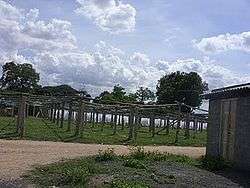Koon Pandiyan
| Koon Pandiyan | |||||
|---|---|---|---|---|---|
| Nindra Seer Nedumaran,[1] Ninraseernedumaran, Kun Pandya | |||||
| Reign | 7th century CE | ||||
| Spouse | Mangayarkkarasiyar | ||||
| |||||
| Dynasty | Pandya | ||||
Koon Pandiyan (Tamil: கூன் பாண்டியன், "The hunch-backed Pandyan") was the nickname of a king who ruled Madurai around 7th century. Historians identify him with the Pandyan king Arikesari Parankusa Maravarman.[2]
He converted from Shaivism to Jainism, but then re-converted under the influence of Sambandar. According to a Saivite legend, after his re-conversion, he ordered a massacre of 8000 Jains in Samanatham.[3] Sambandar is said to have cured his hunched back, after which he was known as Sundara Pandya ("Beautiful Pandyan").[4]
Conversion to Shaivism

In the 7th century, Jainism was one of the major religions in South India. The king Koon Pandian had embraced Jainism, but wife Mangaiarkkarasi and his minister Kulachirai Nayanar were both Shaivites. When the king suffered from an boils and incurable fever, the two invited the Shaivite saint Sambandar to Madurai. Sambandar is said to have cured his fever and his hunched back. After this, the king became a Shaivite, and several of his subjects converted to Shaivism during his rule. The Tamil poet Sekkizhar honored Koon Pandiyan, Kulachirai and Mangaiarkkarasi by naming them among the 63 Nayanars in Periya Puranam.[1]
According to a Saivite legend, when the Jains in Samanatham refused to convert to Shaivism, the king ordered their killings with the consent of Sambandar.[5] Around 8000 Jains were said to have been killed by impalement in which the victims were forcefully put over sharp, tall, conical structures in sitting posture.[6] However, this legend is not found in any Jain text, is believed to be a fabrication made up by the Saivites to prove their dominance.[7][8]
Legacy
Koon Pandiyan is said to have died without a legitimate heir, and after his death, a number of claimants fought with each other to control the kingdom.[9]
References
- 1 2 "Staunch devotion". The Hindu (Chennai). 2009-05-15. Retrieved 2013-02-25.
- ↑ "The Temple At Thirunallar". District Administration, Karaikal. Retrieved 2013-02-25.
- ↑ Paul Dundas (2002). The Jains. Routledge. p. 127. ISBN 978-0-415-26606-2. Retrieved 2013-02-25.
- ↑ Marco Polo; Sir Henry Yule (1875). The Book of Sir Marco Polo, the Venetian, Concerning the Kingdoms and Marvels of the East: Newly Tr. and Ed., with Notes, Maps, and Other Illustrations. J. Murray. pp. 317–. Retrieved 16 August 2013.
- ↑ James Hastings (2003). Encyclopedia of Religion and Ethics Part 9. Kessinger Publishing. p. 23. ISBN 978-0-7661-3680-9. Retrieved 2013-02-25.
- ↑ Tamil Literature - M. S. Pillai - Google Books. Books.google.com. Retrieved 2013-02-14.
- ↑ Ashim Kumar Roy (1984). "9. History of the Digambaras". A history of the Jainas. Gitanjali. Retrieved 22 May 2013.
- ↑ K. A. Nilakanta Sastri (1976). A history of South India from prehistoric times to the fall of Vijayanagar. Oxford University Press. p. 424. Retrieved 23 May 2013.
- ↑ James Henry Nelson (1989). The Madura Country: A Manual. Asian Educational Services. p. 2. ISBN 978-81-206-0424-7. Retrieved 25 February 2013.